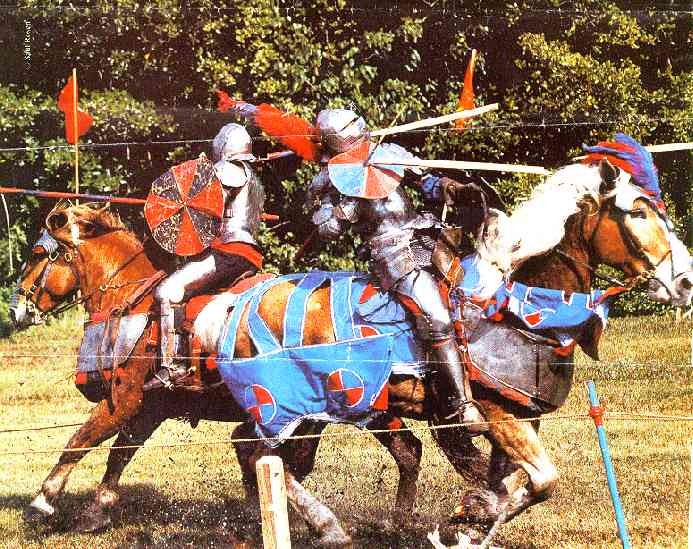

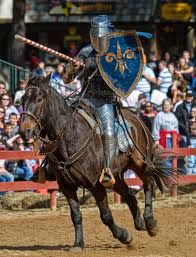
The main types are identified below:
(1) Joust
In contrast to the tournament, which comprised teams of large numbers ranging over large tracts of land, the joust was fought between two individuals on horseback, in a small, defined ground often known as the lists. The two would ride at each other from opposite ends, charging with a couched lance. In the early fifteenth century, a barrier was introduced to keep the horses apart, to avoid collisions. More informal jousting events would have several horsemen within the lists at once, where each waited to take up the challenge of another, although the aim remained for the joust to be a one-on-one duel. There were several types of joust, including some regional preferences or rules. For example, in fourteenth century Germany, distinction was made between the Hohenzeuggestech, where the aim was to break the lance, and the Scharfrennen, where knights sought to unhorse their opponents. These types called for different lances (light in the former, heavy in the latter), and saddles (where the Scharfrennen called for saddles without front or rear supports, which would impede the fall).
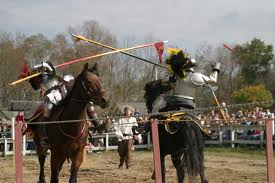
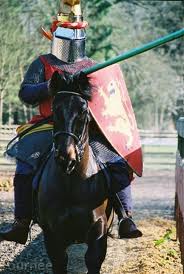
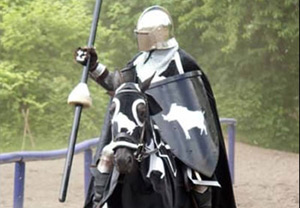
The name is derived from lancea, Roman auxiliaries' javelin, although according to the OED, the word may be of Iberian origin. Also compare longche, a Greek term for lance.
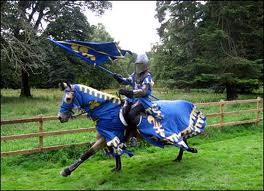
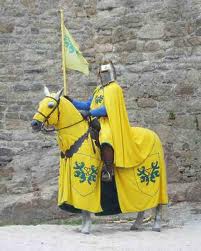
Ancient times The first use of the lance in this sense was made by the Sarmatian and Parthian cataphracts from ca. the 3rd century BC, and cavalry long thrusting spear was especially popular among the Hellenistic armies' agema and line cavalry.
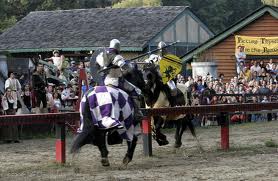
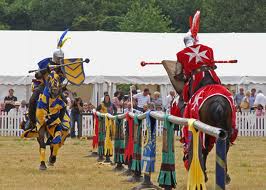
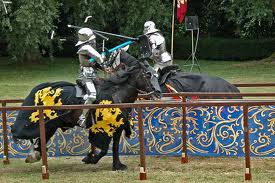
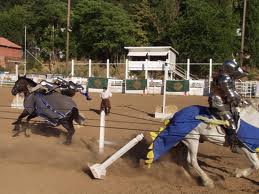
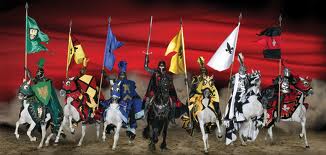
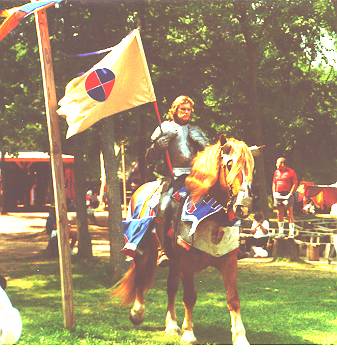
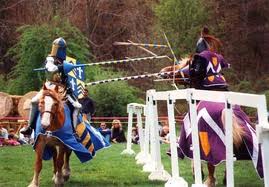
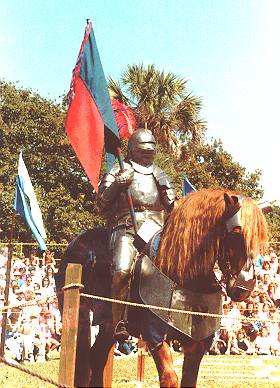
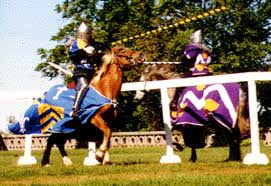
After the Western introduction of the horse to Native Americans, the Plains Indians also took up the lance, probably independently, as American cavalry of the time were sabre- and pistol-armed, firing forward at full gallop. The natural adaptation of the throwing spear to a stouter thrusting and charging spear appears to be an inevitable evolutionary trend in the military use of the horse, and a rapid one at that.
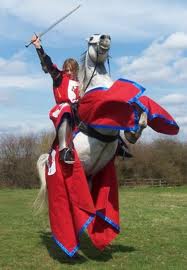
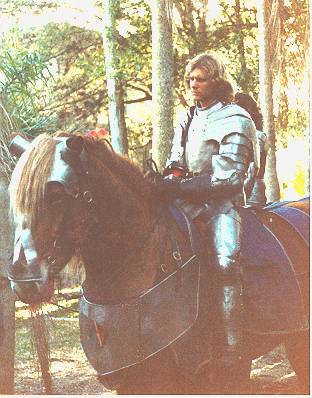
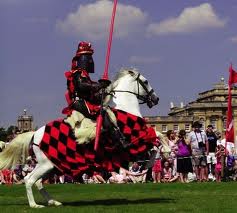
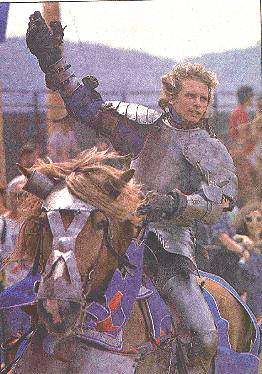
There are many thousands of accounts of pas d'armes during this period. One notable and special account is that of Suero de Quiñones who in 1433 established the Passo Honroso ("Pass[age] of Honor") at the Órbigo bridge in Castile. This road was used by pilgrims all over Europe on the way to shrine at Santiago de Compostela and it was June when thousands would pass. Suero and ten knights promised to fight 300 times ("break 300 lances") before leaving the pas d'armes. He and his men fought for over a month, an account of which is left to us in great detail by town notary Don Luis Alonso Luengo who kept a detailed first-hand chronicle (latter published as Libro del Passo honroso). After 166 battles Suero and his men were so injured they could not continue and declared the mission complete. Suero de Quiñones became legendary in Spanish history and was mentioned in Don Quixote, the 1605 satire on the sort of romantic chivalry out of touch with reality.
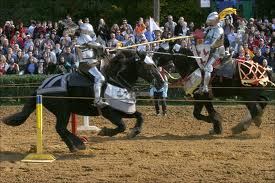
 Passo de la Fuerte Ventura (1428)
 Pas de l'Arbre Charlemagne (1443)
~ Pas de l'Arbre d'Or (1468)
~ Pas de la Belle Pélerine (1449)
~ Pas de la Bergère (1449)
~ Pas du Chevalier au Cygne (1454)
~ Pas de la Dame Inconnue (1463)
~ Pas de la Dame Sauvage (1470)
~ Pas de la Fontaine des Pleurs (1449-1450)
~ Passo de la Fuerte Ventura (1428)
~ Passo Honroso (1434)
~ Pas de la Joyeuse Garde (1446)
~ Pas de la Pastourelle (around 1445)[2]
~ Pas du Perron Feé (1463)
~ Pas du Pin aux Pommes d'Or (1455)
~ Pas de la Rocher Périlleux (1445)
~ Pas de l'Arbre d'Or
(3) Melee Melee, French: Melee, the French spelling is also quite frequent in English writing), or sometimes referred to as "brawl", generally refers to disorganized close combat involving a group of fighters. A melee ensues when groups become locked together in combat with no regard to group tactics or fighting as an organized unit; each participant fights as an individual.
Origin of the term The French term is the feminine past participle of the verb meler "to mix". Nominalized, it refers to any confused tangle or agitated scramble, in particular unordered combat. The term descends from Old French meslede, from Vulgar Latin misculÄta "mixed", from Latin miscÄ“re "to mix"; compare mélange, milieu.
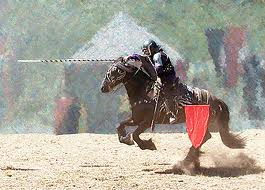
Medieval use During the Middle Ages, tournaments often contained a melee consisting of knights fighting one another on foot or while mounted, either divided into two sides or fighting as a free-for-all. The object was to capture opposing knights so that they could be ransomed, and this could be a very profitable business for such skilled knights as William Marshal. There was a tournament ground covering several square miles in northern France to which knights came from all over Europe to prove themselves in quite real combat. This was, in fact, the original form of tournaments and the most popular between the twelfth and thirteenth centuries—jousting being a later development, and one that did not completely displace the melee until many more centuries had passed. The original mêlée was engaged with normal weapons and fought with as much danger as a normal battle. Rules slowly tempered the danger, but at all times the melee was more dangerous than the joust.
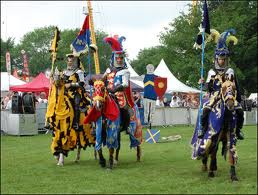

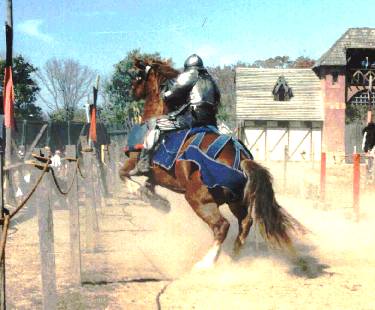
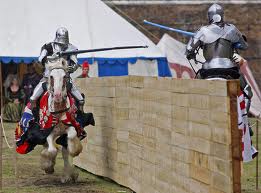
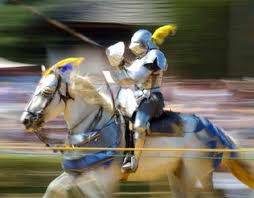
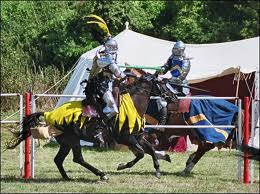
RESOURCE LINKS:

National Jousting Association of Virginia

Amateur Jousting Club of Maryland, Inc.

International Jousting Association, Australian Chapter

Renaissance and Medieval Studies Association, New York State University
BACK TO THE MAIN PAGE
Back to the Main Page:

Behourd Quintain

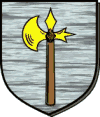
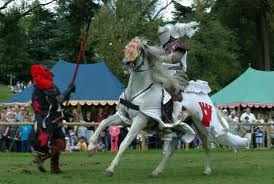

The best known historic feature of the village of Offham in Kent is the Quintain, situated on the Green, a supposedly Roman invention which was popular in Elizabethan times as a means of testing the agility of horsemen.
Writing in 1798 in his History of Kent Hasted says:
"On Offham green there stands a Quntin, a thing now rarely to be met with, being a machine much used in former times by youth, as well to try their own activity as the swiftness of their horses in running at it. The cross piece of it is broad at one end, and pierced full of holes; and a bag of sand is hung at the other and swings round, on being moved with any blow.

When Q Elizabeth was at the Earl of Leicester's, at Kenelworth Castle, among other sports for her entertainment, the running at the quintain was exhibited in the castle-yard by the country lads and lassies assembled on that day, to celebrate a rural wedding."
During the Second World War the quintain was removed for safety to Quintain House, as it could have assisted an invading army as a landmark.
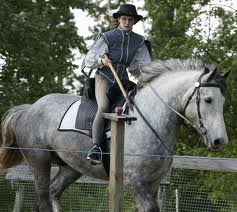
The stone and plaque explaining the history of the Quintain was unveiled on Saturday, 15 September 1951 in the presence of General Sir E. Thomas Humphreys (Chairman of the Parish Council)(minutes of Offham Parish Council), Mrs Emily Cosgrave and Colonel A. M. Wilkinson as part of the Festival of Britain celebrations. A replica quintain was used in the 1980s for tilting on horseback during the annual May Day celebrations, but this has been curtailed due to safety concerns. Responsibility for upkeep and maintenance of the Quintain now rests with the Parish Council.
The Offham Quintain is a Grade II listed monument and further details are given in the Images of England entry.
(4) Tupinaire While frequently referred to by contemporary sources, and included (separately) in various prohibitions and declarations over the medieval period, little is known about the nature of the tupinaire. It is clearly a hastilude, or wargame, of some kind, and distinct from the other types, but there seems to be no clear description of its rules.
(5) Aventuras quaerare Literally, 'seeking adventures'.
(6) Feat of Arms
(7) Chivalric Combat

Origins Unlike trial by ordeal in general, which is known to many cultures worldwide, the trial by combat is known primarily from the customs of the Germanic peoples. It was in use among the ancient Burgundians, Ripuarian Franks, Alamans,Lombards, and Swedes (but is notably absent from Anglo-Saxon law). It was unknown in Roman law and does not figure in the traditions of oriental antiquity such as the code of Hammurabi or the Torah.
The practice is regulated in various Germanic legal codes. Being rooted in Germanic tribal law, the various regional laws of the Frankish Empire (and the later Holy Roman Empire) prescribed different particulars, such as equipment and rules of combat. The Sachsenspiegel prescribes combat with sword and shield, while the Schwabenspiegel prescribes combat with shields and wooden clubs. The Lex Alamannorum (recensio Lantfridana 81, dated to 712-30 AD) prescribes a trial by combat in the event of two families disputing the boundary between their lands. A handful of earth taken from the disputed piece of land is put between the contestants and they are required to touch it with their swords, each swearing that their claim is lawful. The losing party besides forfeiting their claim to the land is required to pay a fine.
Capitularies governing its use appear from the year 803 onwards (Boretius 1.117). Louis the Pious prescribed combat between witnesses of each side rather than between the accuser and the accused, and briefly allowed for the Ordeal of the Cross in cases involving clerics.
In medieval Scandinavia, the practice survived throughout the Viking Age in the form of the Holmgang.
Holy Roman Empire

The Kleines Kaiserrecht, anonymous legal code of ca. 1300, prohibits judicial duels altogether, stating that the emperor had come to this decision on seeing that too many innocent men were convicted by the practice just for being physically weak. Nevertheless, judicial duels continued to be popular throughout the 14th and 15th centuries.
Trial by combat plays a significant role in the German schools of fencing in the 15th century. Notably Hans Talhoffer depicts techniques to be applied in such duels, separately for the Swabian(sword and shield) and Franconian (mace and shield) variants, but other Fechtbücher such as that of Paulus Kal and the Codex Wallerstein show similar material. While commoners were required to present their case to a judge before dueling, members of the nobility did have the right to challenge each other for duels without the involvement of the judicative, so that duels of this kind were separate from the judicial duel already in the Middle Ages and were not affected by the latter's abolition in the early 16th century, evolving into the gentlemanly duel of modern times which was outlawed only as late as in the 19th century.
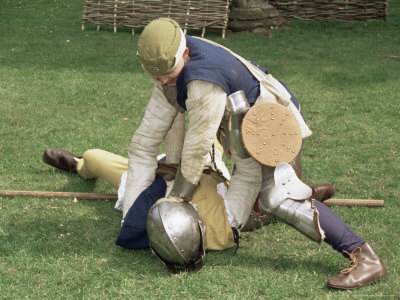 Hans Talhoffer in his 1459 Thott codex names seven offences that in the absence of witnesses were considered grave enough to warrant a judicial duel, viz. murder, treason, heresy, desertion of one's lord, "imprisonment" (possibly in the sense of abduction), perjury/fraud and rape.
Hans Talhoffer in his 1459 Thott codex names seven offences that in the absence of witnesses were considered grave enough to warrant a judicial duel, viz. murder, treason, heresy, desertion of one's lord, "imprisonment" (possibly in the sense of abduction), perjury/fraud and rape.
The introduction of the Reichskammergericht in 1495 tilted the balance in favor of Roman law over regional legal traditions, and the practice of judicial dueling died out shortly thereafter. The compendium of Paulus Hector Mair (1540s) dedicates one of its 16 books to judicial combat (book O 15). As the medieval tournament, Mair describes the practice as a venerable manly custom of the past, giving an account of a specific duel that took place in his hometown of Augsburg in 1409.
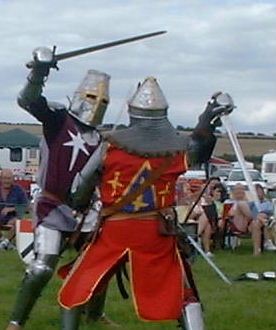 Britain
Wager of battle, as the trial by combat was called in English, appears to have been introduced into the common law of the Kingdom of England following the Norman conquest and remained in use for the duration of the High and Late Middle Ages. The last certain trial by battle in England occurred in 1446: a servant accused his master of treason, and the master drank too much wine before the battle and was slain by the servant. In Scotland and Ireland, the practice was continued into the 16th century.
Britain
Wager of battle, as the trial by combat was called in English, appears to have been introduced into the common law of the Kingdom of England following the Norman conquest and remained in use for the duration of the High and Late Middle Ages. The last certain trial by battle in England occurred in 1446: a servant accused his master of treason, and the master drank too much wine before the battle and was slain by the servant. In Scotland and Ireland, the practice was continued into the 16th century.
The wager of battle was not always available to the defendant in an appeal of murder. If the defendant were taken in the mainour (that is, in the act of committing his crime), if he attempted to escape from prison, or if there was such strong evidence of guilt that there could be no effective denial, the defendant could not challenge. Similarly, if the plaintiff was a woman, or above 60 years of age, or a minor, or if he were lame or blind, he could decline the challenge, and the case would be determined by a jury. Peers of the realm, priests, and citizens of the City of London could also decline the battle if challenged. If the actual battle took place, it would occur in judicial lists, 60 feet (18 m) square, following the taking of oaths against witchcraft and sorcery. If the defendant was defeated, and if he was still alive, he was to be hanged on the spot. However, if he defeated his opponent, or if he were able to fend off his opponent from sunrise to sunset, he would go free. If the plaintiff said the word craven ("I am vanquished"), and gave up the fight, he was to be declared infamous, deprived of the privileges of a freeman, and was liable for damages to his successful opponent.
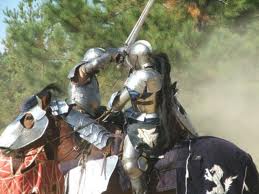 Middle Ages
The earliest case in which wager of battle is recorded was Wulfstan v. Walter (1077), eleven years after the Conquest. Significantly, the names of the parties suggest that it was a dispute between a Saxon and a Norman. The Tractatus of Glanvill, from around 1187, appears to have considered it the chief mode of trial, at least among aristocrats entitled to bear arms.
Middle Ages
The earliest case in which wager of battle is recorded was Wulfstan v. Walter (1077), eleven years after the Conquest. Significantly, the names of the parties suggest that it was a dispute between a Saxon and a Norman. The Tractatus of Glanvill, from around 1187, appears to have considered it the chief mode of trial, at least among aristocrats entitled to bear arms.
When Henry II reformed English civil procedure in the Assize of Clarendon in 1166, trial by jury became available, and lawyers, guarding the safety of the lives and limbs of their clients, steered people away from the wager of battle. A number of legal fictions were devised to enable litigants to avail themselves of the jury even in the sort of actions that were traditionally tried by wager of battle. The practice of averting trial by combat led to the modern concept of attorneys representing litigants. In practice, a person facing trial by combat was assisted by a second, often referred to as a squire. The role of the squire was not only to attend the battle, but to arrange the particulars of the ceremony with the opposing squire. Over time, squires would meet and resolve the disputes during negotiations over combat.
 Trials by combat at common law in England were carried on with quarter staves, on a dueling ground of sixty feet square. Each litigant was allowed a rectangular, leathern shield, and could be armed with a suit of armor, provided that they were bare to the knees and elbows, and wore only red sandals on their feet. The litigants appeared in person; women, the elderly, the infirm of body, and minors could have champions named to fight in their stead. The combat was to begin before noon, and be concluded before sunset. Before fighting, each litigant had to swear an oath disclaiming the use of witchcraft for advantage in the combat, which oath is in words and figures as follows:
Trials by combat at common law in England were carried on with quarter staves, on a dueling ground of sixty feet square. Each litigant was allowed a rectangular, leathern shield, and could be armed with a suit of armor, provided that they were bare to the knees and elbows, and wore only red sandals on their feet. The litigants appeared in person; women, the elderly, the infirm of body, and minors could have champions named to fight in their stead. The combat was to begin before noon, and be concluded before sunset. Before fighting, each litigant had to swear an oath disclaiming the use of witchcraft for advantage in the combat, which oath is in words and figures as follows:
Hear this, ye justices, that I have this day neither eat, drank, nor have upon me, neither bone, stone, ne grass; nor any enchantment, sorcery, or witchcraft, whereby the law of God may be abased, or the law of the Devil exalted. So help me God and his saints.
Either combatant could end the fight and lose his case by crying out the word "Craven",[1] from the Old French for "broken", which acknowledged "(I am) vanquished." The party who did so, however, whether litigant or champion, was punished with outlawry. Fighting continued until one party or the other was dead or disabled. The last man standing won his case.
One of the last mass trials by combat in Scotland, the Battle of the Clans, took place in Perth in 1396. This event took the form of a pitched battle between teams of around thirty men each, representing Clan Macpherson and Clan Davidsonon the North Inch in front of the King, Robert III. The battle was intended to resolve a dispute over which clan was to hold the right flank in an upcoming battle of both clans (and several others) against Clan Cameron. The Clan Macpherson is thought to have won but only twelve men survived from the original sixty.
 16th century
The last trial by combat under the authority of an English monarch is thought to have taken place during the reign of Elizabeth I, in the inner courtyard of Dublin Castle in Ireland at 9 o'clock on the morning of 7 September 1583.
16th century
The last trial by combat under the authority of an English monarch is thought to have taken place during the reign of Elizabeth I, in the inner courtyard of Dublin Castle in Ireland at 9 o'clock on the morning of 7 September 1583.
The dispute was between members of the O'Connor clan (i.e., sept) in King's county (modern County Offaly), who were persuaded by two judges (referred to in the account below) to bring the matter before the Irish privy council for resolution.
The dispute probably concerned dynastic power within the territory of the O'Connors, and the parties, Teig and Conor, had accused each other of treason; the privy council granted their wish for trial by combat, to take place on the following day, and for another such trial between two other members of the same sept, to take place on the Wednesday following.
The first combat took place as appointed, with the combatants "in their shirts with swords, targetts and skulles". An account of the proceedings as observed by one of the Privy Councilors is given in the State papers Ireland 63/104/69 (spelling adapted):
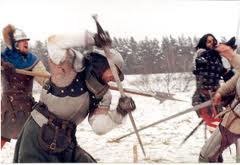 The first combat was performed at the time and place accordingly with observation of all due ceremonies as so short a time would suffer, wherein both parties showed great courage by a desperate fight: In which Conor was slain and Teig hurt but not mortally, the more was the pity: Upon this Wednesday following Mortogh Cogge [O'Connor] appeared in the same place brought by the captains to the listes, and there stayed 2 hours making proclamation against his enemy by drum and trumpet, but he appeared not ... The only thing we commend in this action was the diligent travail of Sir Lucas Dillon and the Master of the Rolls, who equally and openly seemed to countenance the champions, but secretly with very good concurrence, both with us and between themselves, with such regard of her Majesty's service, as giveth us cause to commend them to your Lordships.
The first combat was performed at the time and place accordingly with observation of all due ceremonies as so short a time would suffer, wherein both parties showed great courage by a desperate fight: In which Conor was slain and Teig hurt but not mortally, the more was the pity: Upon this Wednesday following Mortogh Cogge [O'Connor] appeared in the same place brought by the captains to the listes, and there stayed 2 hours making proclamation against his enemy by drum and trumpet, but he appeared not ... The only thing we commend in this action was the diligent travail of Sir Lucas Dillon and the Master of the Rolls, who equally and openly seemed to countenance the champions, but secretly with very good concurrence, both with us and between themselves, with such regard of her Majesty's service, as giveth us cause to commend them to your Lordships.
The Annals of the Four Masters also refers to the trial and censures the parties for having allowed the English to entice them into the proceedings. It is also referred to in Holinshed's chronicles. This was a trial not at common law but underconsiliar jurisdiction. Modern era.
It is uncertain when the last actual trial by battle in Britain took place. While some references speak of such a trial being held in 1631, records indicate that King Charles I intervened to prevent the battle. A 1638 case is less clear: it involved Ralf Claxton and Richard Lilburne (the father of John Lilburne) and the King again stepped in and judges acted to delay proceedings. No record survives of the outcome of the case, but no contemporary account speaks of the trial by battle actually taking place. The last certain judicial battle in Britain was in Scotland in 1597, when Adam Bruntfield accused James Carmichael of murder, and killed him in battle.
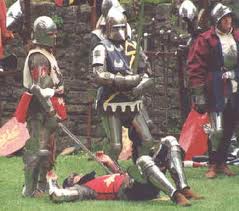 Proposals to abolish trial by battle were made in the 17th century, and twice in the 18th, but were unsuccessful. In 1774, as part of the legislative response to the Boston Tea Party, Parliament considered a bill which would have abolished appeals of murder and trials by battle in the American colonies. It was successfully opposed by MP John Dunning, who called the appeal of murder "that great pillar of the Constitution". Writer and MP Edmund Burke, on the other hand, supported the abolition, calling the appeal and wager "superstitious and barbarous to the last degree".
Proposals to abolish trial by battle were made in the 17th century, and twice in the 18th, but were unsuccessful. In 1774, as part of the legislative response to the Boston Tea Party, Parliament considered a bill which would have abolished appeals of murder and trials by battle in the American colonies. It was successfully opposed by MP John Dunning, who called the appeal of murder "that great pillar of the Constitution". Writer and MP Edmund Burke, on the other hand, supported the abolition, calling the appeal and wager "superstitious and barbarous to the last degree".
The writ of right was the most direct way at common law of challenging someone's right to a piece of real property. The criminal appeal was a private criminal prosecution instituted by the accuser directly against the accused. It was not, unlike the contemporary appeal, a proceeding in a court of superior jurisdiction reviewing the proceedings of a lower court.
Such a private prosecution was last conducted in the case of Ashford v Thornton in 1818, as recorded in The Newgate Calendar. Pronouncing judgment in favor of the accused's plea claiming the wager of battle, Justice Bayley of theKing's Bench said that:
One of the inconveniences of this procedure is, that the party who institutes it must be willing, if required, to stake his life in support of his accusation.
The accusation was quickly withdrawn after this judgement. Parliament abolished wager of battle the following year, in 1819, and at the same time they also abolished the writ of right and criminal appeals. In December 2002, a 60-year-old mechanic named Leon Humphreys was fined £25 for failing to notify the Driver and Vehicle Licensing Agency that he had removed his Suzuki motorcycle from road usage. He refused to pay and claimed that he had the right, under medieval law, to choose a trial by combat with a "champion" nominated by the DVLA. This claim was denied by a court of magistrates in Bury St Edmunds, and he was further fined.
France Judicial combat of 1386 In December 1386, the last trial by combat authorized by the French King Charles VI was fought in Paris. The trial was fought to decide a case brought by Sir Jean de Carrouges against squire Jacques Le Gris, whom he accused of raping his wife Marguerite when Carrouges was in Paris conducting business. After lengthy hearings at the Parlement de Paris, it was decided that guilt could not be decided through a standard jury trial and a judicial duel was ordered.
In late December, shortly after Christmas, the combatants met in the grounds of an abbey in the Northern Paris suburbs. After lengthy ceremony battle was joined and after a furious and bloody encounter, Carrouges stabbed his opponent through the throat with his dagger and claimed victory, being rewarded with substantial financial gifts and a position in the Royal household. The duel was watched by the Royal court, several royal dukes and thousands of ordinary Parisians and was recorded in several notable chronicles including Froissart's Chronicles and Grandes Chroniques de France. It has since been covered by several notable texts, including Diderot's Encyclopédie, Voltaire and the Encyclopedia Britannica Eleventh Edition, and also by the 2004 book The Last Duel by Eric Jager.
United States The United States inherited its common law traditions from the English system after it declared its independence in 1776, with precedents before that date entrenched in the American jurisprudence, as the Rule in Shelley's Case in property law has. The British, however, did not abolish wager by battle until 1819 after Ashford v Thornton, as noted above, and since independence no court in the United States has addressed the issue of whether this remains a valid alternative to a civil action under the law. In Forgotten Trial Techniques: The Wager of Battle, by Donald J Evans published in the ABA Journal 71:66 (May 1985), the possibility of a trial by battle was set out in a parody of hard-boiled pulp fiction author Raymond Chandler but set in a lawyer's office.
Round Table Debate exists amongst historians as to whether the term Round Table refers to a specific type of hastilude, or if it refers to the social event surrounding one of the other types of hastilude.
Though the first recorded tournament was staged in 1066, jousting itself did not gain in widespread popularity until the 12th century. It maintained its status as a popular European sport until the early 17th century. Jousting was added to tournaments several centuries after their inauguration. The joust permitted a better display of individual skill and, although dangerous, offered large sums of prize money. Many knights made their fortune in these events, whilst many lost their fortune or even life. For example, Henry II of France died when his opponent's lance went through his visor and shattered into fragments, blinding his right eye and penetrating his right orbit and temple.
Medieval jousting The skills used in tournaments were a reflection of the skills applied in battle where the primary purpose was to try to kill or disable an opponent. The primary purpose of the justing lance is to unhorse the other by striking them with the end of the lance while riding towards them at high speed. This is known as "tilting". Other weapons were also used for jousting.
War put on hold for a joust The 1300s document (translated from French) called The Chronicles of Froissart contains many details concerning jousting in medieval times. For example, much can be gleaned from its account of a war put on hold for a joust as it illustrates and documents:
~ the connection between romance and jousting
~ the importance associated with jousting
~ the nonlethal expectations
~ the use of attendants
~ the rounds consisting of three encounters with various weapons
~ jousting being stopped when the risk of death seemed too great
~ During the Medieval times or the age of faith
~ the financial rewards of acquitting yourself well
~ tournaments contained jousts but jousts were also done outside of tournaments
~ jousts contained tilts but tilts were but one type of armed encounter during a joust
~ jousting as sport and not war was done between enemies during a war between warring sides, at least this once
~ the completion of a joust could be delayed days and finished later
~ standards of conduct considered honorable
~ knights on horseback galloping towards each other somewhat like gladiators
The Chronicles of Froissart records that, during a campaign in the Gatinois and the Beauce in France during the Hundred Years War between the English and French, a squire from Beauce named Gauvain Micaille yelled out to the English, "Is there among you any gentleman who for the love of his lady is willing to try with me some feat of arms? If there should be any such, here I am, quite ready to sally forth completely armed and mounted, to tilt three courses with the lance, to give three blows with the battle axe, and three strokes with the dagger. Now look, you English, if there be none among you in love."
This is what Froissart says happened next:
His proposal and request was soon spread among the English, when a squire, an expert man at tournaments, called Joachim Cator, stepped forth and said, "I will deliver him from his vow: let him make haste and come out of the castle."
Upon this, the lord Fitzwalter, marshal of the army, went up to the barriers, and said to sir Guy de Baveux, "Let your squire come forth: he has found one who will cheerfully deliver him; and we will afford him every security."
Gauvian Micaille was much rejoiced on hearing these words. He immediately armed himself, in which the lords assisted, in putting on the different pieces, and mounted him on a horse, which they gave to him. Attended by two others, he came out of the castle; and his varlets carried three lances, three battle-axes, and three daggers. He was much looked at by the English, for they did not think any Frenchman would have engaged body to body. There were besides to be three strokes with a sword, and with all other sorts of arms. Gauvain had three brought with him for fear any should break.
The earl of Buckingham, hearing of this combat, said he would see it, and mounted his horse, attended by the earls of Stafford and Devonshire. On this account, the assault on Toury ceased. The Englishman that was to tilt was brought forward, completely armed and mounted on a good horse. When they had taken their stations, they gave to each of them a spear, and the tilt began; but neither of them struck the other, from the mettlesomeness of their horses. They hit the second onset, but it was by darting their spears; on which the earl of Buckingham cried out, "Hola hola! It is now late. Put an end to it, for they have done enough this day: we will make them finish it when we have more leisure than we have at this moment, and take great care that as much attention is paid to the French squire as to our own; and order someone to tell those in the castle not to be uneasy about him, for we shall carry him with us to complete his enterprise, but not as a prisoner; and that when he shall have been delivered, if he escape with his life, we will send him back in all safety."
On the day of the feast of our Lady, Gauvain Micaille and Joachim Cator were armed, and mounted to finish their engagement. They met each other roughly with spears, and the French squire tilted much to the satisfaction of the earl: but the Englishman kept his spear too low, and at last struck it into the thigh of the Frenchman. The earl of Buckingham as well as the other lords were much enraged by this, and said it was tilting dishonorably; but he excused himself, by declaring it was solely owing to the restiveness of his horse. Then were given the three thrusts with the sword; and the earl declared they had done enough, and would not have it longer continued, for he perceived the French squire bled exceedingly: the other lords were of the same opinion. Gauvain Micaille was therefore disarmed and his wound dressed. The earl sent him one hundred francs by a herald, with leave to return to his own garrison in safety, adding that he had acquitted himself much to his satisfaction.
Equipment Lists The lists, or list field, is the arena in which a jousting event or similar tournament is held. More precisely, it is the roped-off enclosure where tournament fighting takes place. It is mentioned frequently in the novel Ivanhoe by Sir Walter Scott. In the late medieval period, castles and palaces were augmented by purpose-built tiltyards as a venue for "jousting tournaments".
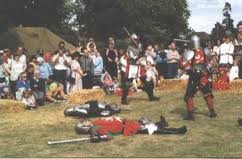 Horse
The two most common kinds of horse used for jousting were warmblood chargers and coldblood destriers. Chargers were medium-weight horses bred and trained for agility and stamina, while destriers were heavy war horses. These were larger and slower, but helpful to give devastating force to the rider's lance through its weight being about twice as great as that of a traditional riding horse. The horses were trained for ambling, a kind of pace that provided the rider with stability in order to be able to focus and aim better with the lance.
During a jousting tournament, the horses were cared for by their grooms in their respective tents. They wore caparisons, a type of ornamental cloth featuring the owner's heraldic signs. Competing horses had their heads protected by a chanfron, an iron shield for protection from otherwise lethal lance hits.
Horse
The two most common kinds of horse used for jousting were warmblood chargers and coldblood destriers. Chargers were medium-weight horses bred and trained for agility and stamina, while destriers were heavy war horses. These were larger and slower, but helpful to give devastating force to the rider's lance through its weight being about twice as great as that of a traditional riding horse. The horses were trained for ambling, a kind of pace that provided the rider with stability in order to be able to focus and aim better with the lance.
During a jousting tournament, the horses were cared for by their grooms in their respective tents. They wore caparisons, a type of ornamental cloth featuring the owner's heraldic signs. Competing horses had their heads protected by a chanfron, an iron shield for protection from otherwise lethal lance hits.
Other forms of equipment on the horse included long-necked spurs which enabled the rider to control the horse with extended legs, a saddle with a high back to provide leverage during the charge or when hit, as well as stirrups for the necessary leverage to deliver blows with the lance.
Armor Jousting was popular from the high Middle Ages until the early 17th century, when it was replaced as the equine highlight of court festivities by large "horse-ballet" displays called carousels, although non-combat competitions such as the ring-tilt lasted until the 18th century. During the period jousting was popular, armor evolved from being chain mail (called simply mail at the time), with a solid, heavy helmet, called a "great helm", and shield. By 1400 knights wore full suits of plate armor, called a "harness". A full harness frequently included extra pieces specifically for use in jousting, so that a light military combat suit could be reinforced with heavier, "bolt-on" protective plates on the cuirass (breastplate) and helmet, and also with jousting-specific arm and shoulder pieces, which traded mobility for extra protection. These extra pieces were usually much stronger on the side expected to take the impact of the lance. Special jousting helmets were sometimes used, made so that the wearer could see out only by leaning forwards. If the wearer straightened up just before the impact of the lance, the eyes would be completely protected. Some later suits had a small shield built-in the left side of the armor. In some cases this was spring loaded to fly into pieces if struck properly by the opponent's lance.
Lance In modern times, jousting is often done for show or demonstration purposes, and the lances used are usually made of light wood and prepared so that they break easily. Lances are often decorated with stripes or the colors of a knight's coat of arms. In a real joust, the lances were of solid oak and a significant strike was needed to shatter them. However, the (blunt) lances would not usually penetrate the steel. The harnesses worn by the knights were lined on the inside with plenty of cloth to soften the blow from the lance.
 Modern jousting
In the UK jousting became a professional sport in the spring of 1972. At the Principality of Gwrych, an abandoned castle converted into a theme park in North Wales near Abergele, a small troupe of horsemen in costume entertained the crowds with two, and sometimes three daily shows. The purpose-built five hundred seat jousting theatre was the first of its kind in Great Britain. From the successes of in this castle a professional group was created a year or so later. The Company of Knights Limited, founded in early 1974 undertook jousting shows ranging from as few as five or six participants to as many as fifty actors. Led by former stuntmen Peter Brace, Roy Street and Mike Horsburgh, and designer-director Chris Miles, the company went on to perform a major tournament for the London Festival in the Tower of London Moat in early July, and later to take part in one of the largest medieval pageants ever staged in the modern era within the city of Bruges, Belgium. In this two hour long performance twelve riders and caparisoned horses took the roles of medieval European knights from 1492. The Tournament of the Silver Parrot at Bruges featured the battle between the Houses of Ghistele and Gruuthuuse with over one hundred people in costume, one hundred horses, and actors and show people from Great Britain. Jousting Companies in Britain include The Knights of Arkley, The Knights of Middle England and The Knights of Royal England who perform displays in the grounds of several castles.
Modern jousting
In the UK jousting became a professional sport in the spring of 1972. At the Principality of Gwrych, an abandoned castle converted into a theme park in North Wales near Abergele, a small troupe of horsemen in costume entertained the crowds with two, and sometimes three daily shows. The purpose-built five hundred seat jousting theatre was the first of its kind in Great Britain. From the successes of in this castle a professional group was created a year or so later. The Company of Knights Limited, founded in early 1974 undertook jousting shows ranging from as few as five or six participants to as many as fifty actors. Led by former stuntmen Peter Brace, Roy Street and Mike Horsburgh, and designer-director Chris Miles, the company went on to perform a major tournament for the London Festival in the Tower of London Moat in early July, and later to take part in one of the largest medieval pageants ever staged in the modern era within the city of Bruges, Belgium. In this two hour long performance twelve riders and caparisoned horses took the roles of medieval European knights from 1492. The Tournament of the Silver Parrot at Bruges featured the battle between the Houses of Ghistele and Gruuthuuse with over one hundred people in costume, one hundred horses, and actors and show people from Great Britain. Jousting Companies in Britain include The Knights of Arkley, The Knights of Middle England and The Knights of Royal England who perform displays in the grounds of several castles.
Between 1980 and 1982 a major effort was made in the design of the Little England theme Park in Orlando, Florida to construct a major and unique jousting stadium. Although the first phase of the project was constructed high interest rates cancelled the project. However the sport was taken up by a dinner dining company called Mediaeval Times, and flourishes today (2010).
Modern day jousting or tilting has been kept alive by the International Jousting Association, which has strict guidelines for the quality and authenticity of jousters' armor & equipment, and has developed the use of breakable lance tips for safety.
Jousting under the International Jousting Association rules follows a points system where points are given for breaking the lance tip on the opposing knight's shield; note that there are no points given for unhorsing an opponent. International Jousting Association sanctioned tournaments also include skill at arms where the riders display their horsemanship and weapons handling skills with swords on the Moors Head, they use spears for the rings and spear throw, and use the lance against a spinning quintain. Many International Jousting Association tournaments also include a mounted melee with fully armored riders using padded batons in place of swords for safety. None of the International Jousting Association events are theatrically based and they offer the public a chance to observe living history as opposed to entertainment oriented jousting.
 Today, tent pegging is the only form of jousting officially recognized by the International Federation for Equestrian Sports. The sport involves using a lance or sword to strike and carry away a small wooden ground target. The name "tent pegging" is derived from the cavalry tactic of causing confusion in enemy camps by galloping though the camps and collapsing the tents by pulling up the tent peg anchors with well-placed lance tip strikes. The actual sport of tent pegging, however, originated in medieval India, when horse cavalrymen would try to incapacitate elephant cavalry by striking the elephants with lances on their extremely sensitive toenails.
Today, tent pegging is the only form of jousting officially recognized by the International Federation for Equestrian Sports. The sport involves using a lance or sword to strike and carry away a small wooden ground target. The name "tent pegging" is derived from the cavalry tactic of causing confusion in enemy camps by galloping though the camps and collapsing the tents by pulling up the tent peg anchors with well-placed lance tip strikes. The actual sport of tent pegging, however, originated in medieval India, when horse cavalrymen would try to incapacitate elephant cavalry by striking the elephants with lances on their extremely sensitive toenails.
In 1962, jousting was named the official sport of the state of Maryland; this was the first official sport of any US state. Ring jousting tournaments are held annually.
The Italian town of Foligno also holds an annual jousting tournament, the Giostra della Quintana, that dates back to the 1613. The Knights have to spear rings from the statue of the Quintana.
The Italian town of Arezzo continues to hold an annual jousting tournament, which dates to the Crusades. Jousters aim for a square target attached to a wooden effigy of a Saracen king, whose opposite arm holds a cat-o-three-tails—three leather laces with a heavy wooden ball at the end of each lace. The riders strike the target with chalk-tipped lances and score points for accuracy, but must also dodge the cat-o-three-tails after they have struck the target.
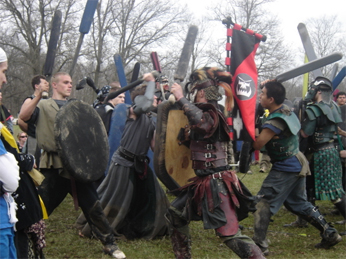 Modern theatrical jousting competitions are popular at American Renaissance fairs and similar festivals, and feature riders on horseback attempting various feats of skill with the lance, which may not always have a basis in history.
Modern theatrical jousting competitions are popular at American Renaissance fairs and similar festivals, and feature riders on horseback attempting various feats of skill with the lance, which may not always have a basis in history.
Several international organizations, such as the Society for Creative Anachronism and the International Jousting Association promote rules to govern their jousting events.
In Port Republic, Maryland the annual Calvert County Jousting Tournament is held every August on the grounds of historic Christ Episcopal Church. In 2005, the tournament was featured in an edition of ESPN's Sports Center.
© 1997-2011 Maggie & John Taylor. All rights reserved.
